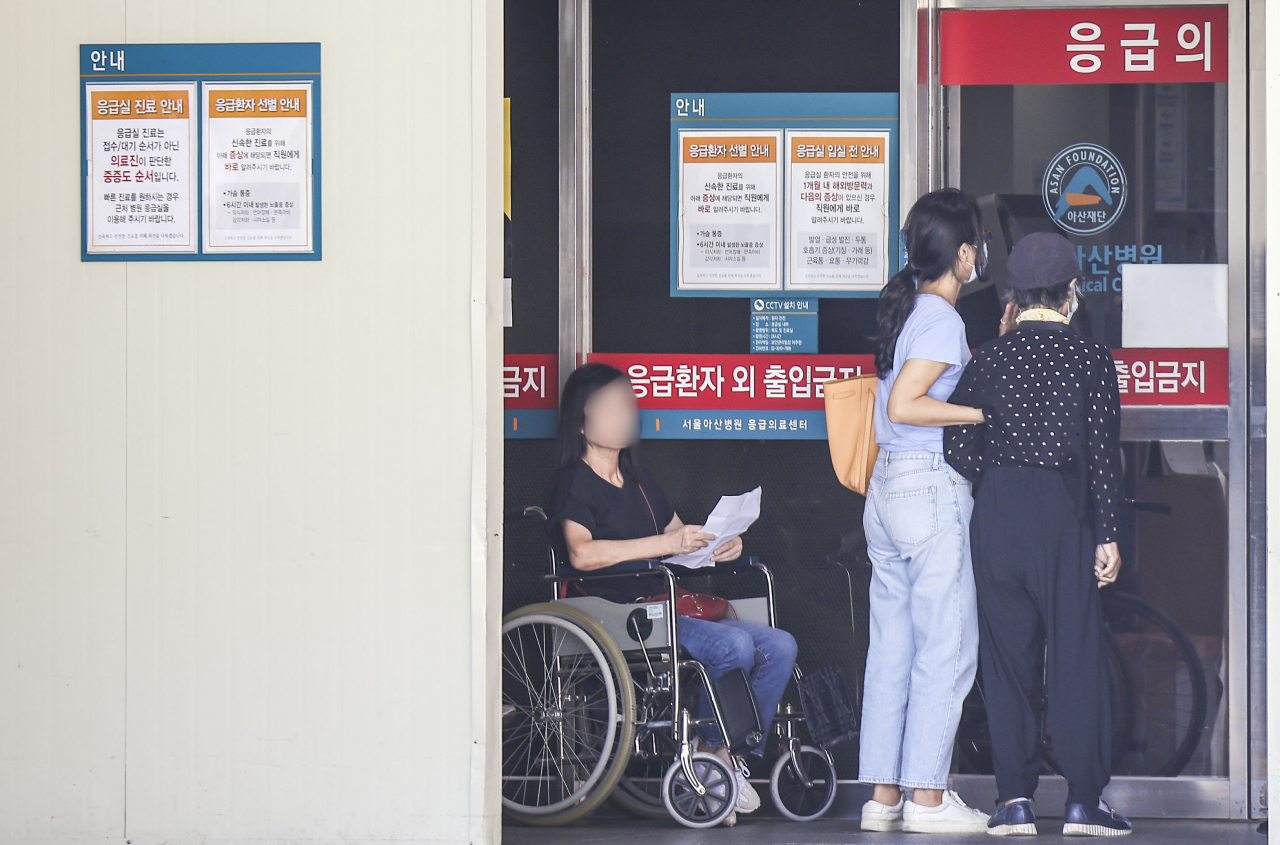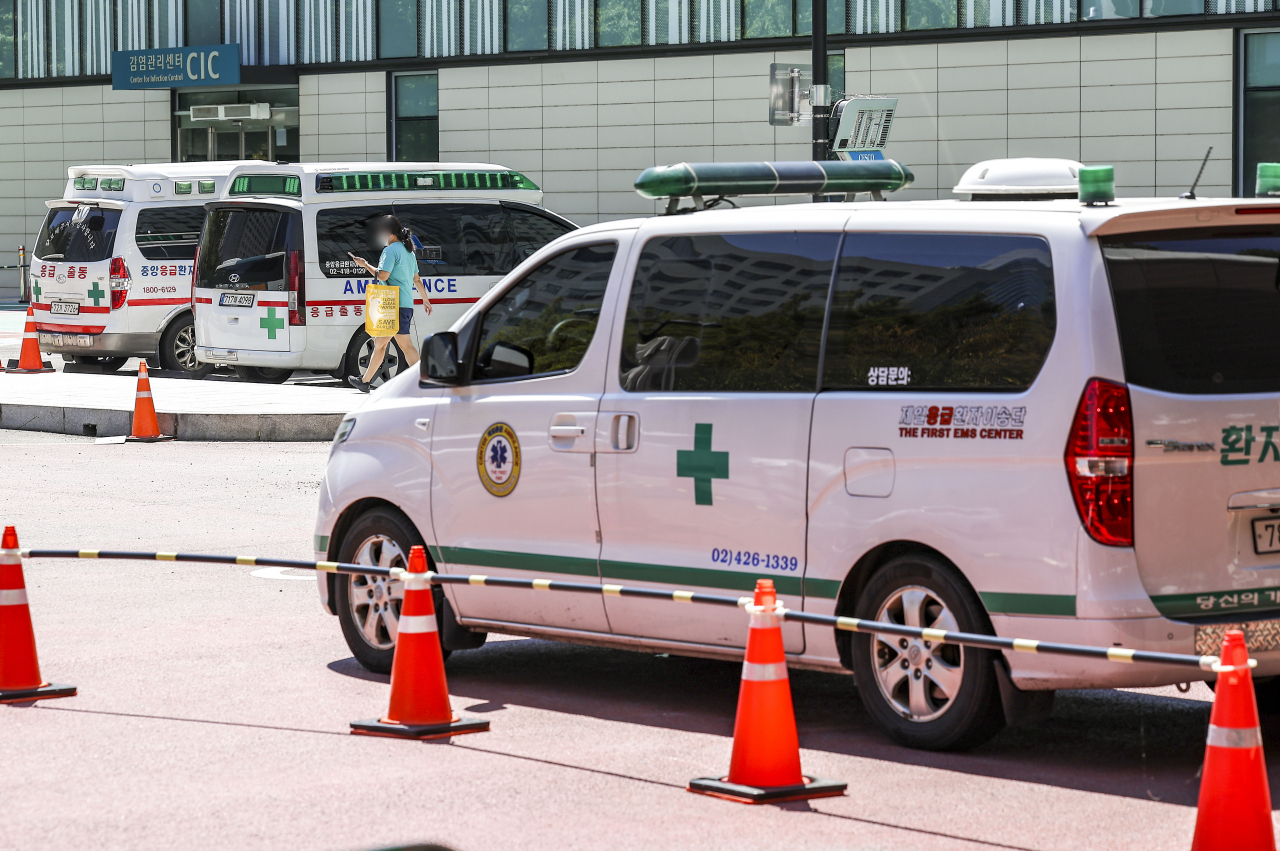 |
Patients are seen in front of the emergency room at the Asan Medical Center in Songpa-gu, southern Seoul, Wednesday. (Newsis) |
Seven months into South Korea's medical sector standoff, fatigue and backlogs of patients are hammering emergency departments nationwide as emergency medicine physicians are reeling from the mass walkout of medical interns and residents in February, with some deciding to leave their jobs for good.
Seven out of 14 ER doctors at Ajou University Hospital in Suwon, Gyeonggi Province, have tendered their resignations, putting the emergency unit under immense pressure as it grapples with personnel shortages that have it operating far under its normal capacity.
All seven emergency physicians at Konkuk University Chungju Hospital have also submitted their resignations. Each doctor had worked 12 hours a day to cover the ER throughout the day and night, becoming overwhelmed until reaching a breaking point.
To deal with the personnel shortage, in Seoul, emergency medicine professors at Ewha Womans University Medical Center, who double as senior physicians, are mulling whether to close the emergency room for two days a week -- on Wednesdays and Thursdays -- starting from next week, according to reports.
Apart from emergency physicians quitting in droves, many of the short-staffed emergency rooms, including at the country's five biggest general hospitals in Seoul, are limiting treatment, even for the critically ill, as they struggle to admit new patients in the face of increased demand for treatment.
Severance Hospital recently announced that it could not accept patients with severe injuries or trauma, while Asan Medical Center's ER said it could not perform surgeries for urgent orthopedic cases or hospitalize new patients due to the staffing crisis.
The staffing shortage has also caused operations at Seoul St. Mary's Hospital's ER unit to start breaking down, as new hematology patients now cannot be admitted. On Tuesday, Seoul National University Hospital informed patients that its emergency center could not perform urgent eye surgery outside of normal operating hours.
"ER doctors usually refer patients to other departments for the specialized treatment they need. But since the hospital is understaffed, other departments cannot accept new patients, so ER doctors, who are already coping with extreme exhaustion, are taking care of them," a senior official at St. Mary's Hospital told The Korea Herald.
In light of the crisis, the Health Ministry said Wednesday it would keep 4,000 hospitals and clinics operational from Sept. 11 to 25 to deal with emergency care before and after the Chuseok holiday period, designating it "Chuseok Holiday Emergency Response Week." The holiday period runs from Sept. 14 through Sept. 18 this year.
The presidential office said the scheme was made to ensure that those in "critical emergencies" can get treatment in the ER during the holiday, assuring that the measures would prevent emergency rooms from becoming overloaded.
As doctors have warned of a worsening medical staffing shortage in operating emergency rooms during Chuseok, health authorities plan to designate specific regional and local medical centers in 29 areas to serve as emergency rooms to handle the most critically ill patients. Military and public hospitals will be operating in emergency mode.
 |
An emergency hospital ambulance car is seen at a university hospital in Seoul on Wednesday. (Newsis) |
In addition, from Sept. 11 to 25, the Health Ministry will raise the price of emergency room visits from 150 percent to 250 percent of the base cost. Currently, using the emergency room costs around 40,000 won ($29.95) at tertiary general hospitals, according to the ministry.
Incentives offered to health care staff for speeding up patient admission and transfers will also be raised. Officials added that the cost of surgeries, medical procedures and the administration of anesthesia will also increase in cases where patients are admitted to the hospital for follow-up care after being treated at the ER.
Information about hospitals, clinics and pharmacies that remain open during the holiday period will be accessible through the emergency medical service portal and local government call centers.
Despite the crisis, the presidential office reiterated its plan to push through medical reforms on the same day, saying the government "stands by its plan" to have 2,000 additional medical student slots every year for the next five years.
The remark comes a day after Han Dong-hoon, the ruling People Power Party chief, proposed deferring the medical school enrollment quota hike for the 2026 academic year on Facebook in an attempt to break through the conflict over the government's plan.
The proposal was also floated after Han held a closed-door meeting with Park Dan, the head of the Korean Intern Resident Association, on Aug. 20, where the two reportedly discussed ways to get the medical interns and residents to return.
While the Medical Professors Association of Korea welcomed the move, a senior presidential official told reporters that the government's stance on its original medical reform plan "remains unchanged." The official added that the postponement would "only create confusion in college admissions," noting that patients struggling to find ERs these days and short consultations between doctors and patients prove the country needs more doctors.



![[Herald Interview] 'Trump will use tariffs as first line of defense for American manufacturing'](http://res.heraldm.com/phpwas/restmb_idxmake.php?idx=644&simg=/content/image/2024/11/26/20241126050017_0.jpg)

![[Health and care] Getting cancer young: Why cancer isn’t just an older person’s battle](http://res.heraldm.com/phpwas/restmb_idxmake.php?idx=644&simg=/content/image/2024/11/26/20241126050043_0.jpg)

